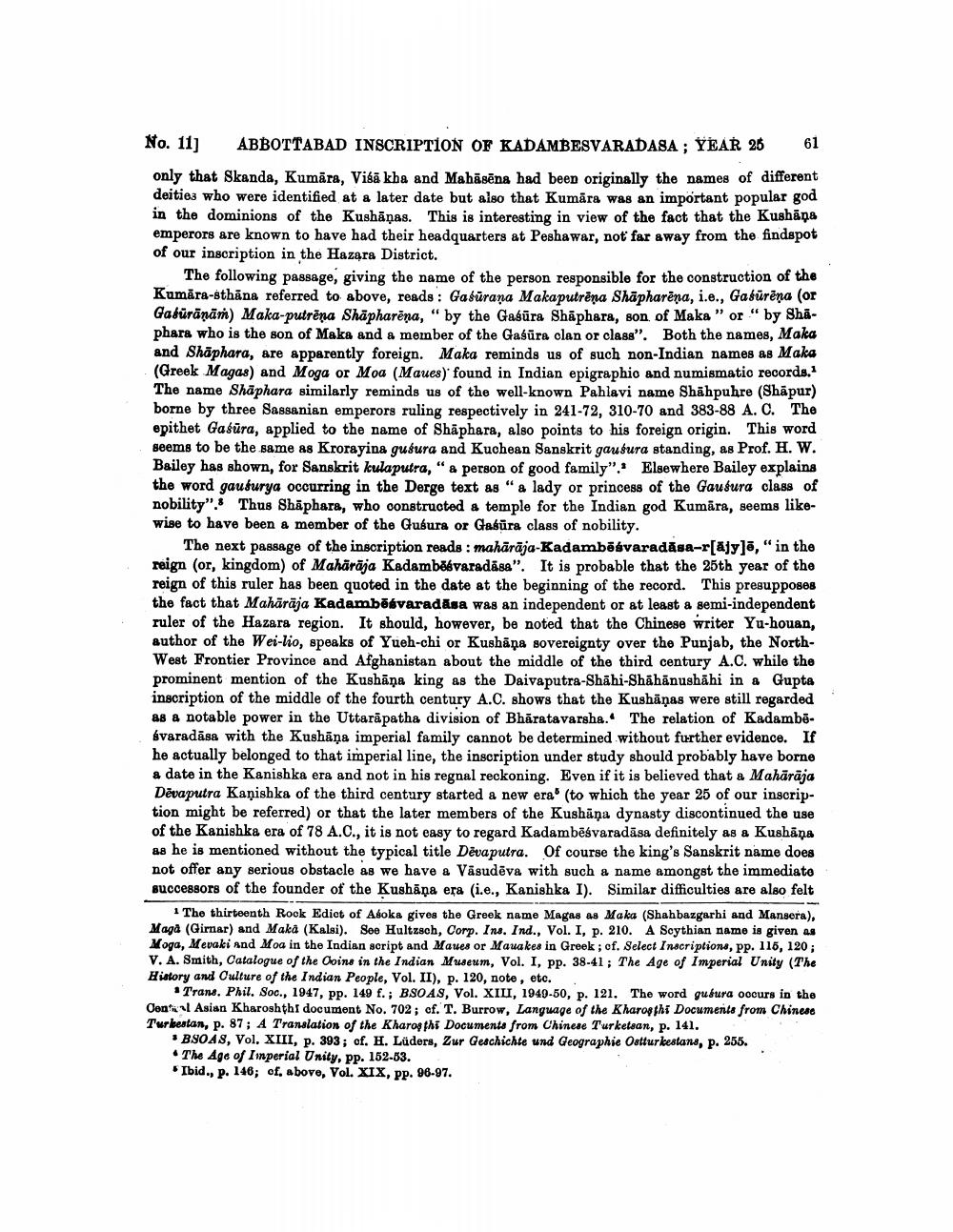________________
No. 11] ABBOTTABAD INSCRIPTION OF KADAMBESVARADASA ; YEAR 26 61 only that Skanda, Kumāra, Vigā kba and Mahāsēna had been originally the names of different deities who were identified at a later date but also that Kumara was an important popular god in the dominions of the Kushānas. This is interesting in view of the fact that the Kushāna emperors are known to have had their headquarters at Peshawar, not far away from the findspot of our inscription in the Hazara District.
The following passage, giving the name of the person responsible for the construction of the Kumāra-sthāna referred to above, reads: Gatūrana Makaputrëna Shāpharēna, i.e., Gafürēna (or Gafürānāṁ) Maka-putrēna Shāpharēna, "by the Gaśūra Shaphara, son of Maka" or " by Shaphara who is the son of Maka and a member of the Gagūra clan or class". Both the names, Maka and Shāphara, are apparently foreign. Maka reminds us of such non-Indian names as Maka (Greek Magas) and Moga or Moa (Maues) found in Indian epigraphio and numismatic records. The name Shāphara similarly reminds us of the well-known Pahlavi name Shāhpuhre (Shāpur) borne by three Sassanian emperors ruling respectively in 241-72, 310-70 and 383-88 A. C. The epithet Gaśūra, applied to the name of Shāphara, also points to his foreign origin. This word seems to be the same as Krorayina gusura and Kuchean Sanskrit garsura standing, as Prof. H. W. Bailey has shown, for Sanskrit kulaputra, "& person of good family".Elsewhere Bailey explains the word gausurya occurring in the Derge text as "& lady or princess of the Gausura class of nobility". Thus Shāphara, who constructed a temple for the Indian god Kumāra, seems likewise to have been a member of the Gusura or Gatūra class of nobility.
The next passage of the inscription reads : mahārāja-Kadambösvaradāsa-r[äjylē," in the reign (or, kingdom) of Maharāja Kadambēévaradása". It is probable that the 25th year of the reign of this ruler has been quoted in the date at the beginning of the record. This presupposes the fact that Mahārāja Kadambēsvaradāsa was an independent or at least a semi-independent ruler of the Hazara region. It should, however, be noted that the Chinese writer Yu-houan, author of the Wei-lio, speaks of Yueh-chi or Kushāņa sovereignty over the Punjab, the NorthWest Frontier Province and Afghanistan about the middle of the third century A.C. while the prominent mention of the Kushāna king as the Daivaputra-Shāhi-Shāhānushāhi in & Gupta inscription of the middle of the fourth century A.C. shows that the Kushāņas were still regarded as & notable power in the Uttara patha division of Bhäratavarsha.. The relation of Kadambēsvaradāsa with the Kushina imperial family cannot be determined without further evidence. If he actually belonged to that imperial line, the inscription under study should probably have borne & date in the Kanishka era and not in his regnal reckoning. Even if it is believed that a Maharaja Dēvaputra Kaņishka of the third century started a new era (to which the year 25 of our inscription might be referred) or that the later members of the Kushina dynasty discontinued the use of the Kanishka era of 78 A.C., it is not easy to regard Kadambēsvaradāsa definitely as a Kushāna as he is mentioned without the typical title Dévaputra. Of course the king's Sanskrit name does not offer any serious obstacle as we have a Vasudēva with such a name amongst the immediate successors of the founder of the Kushāņa era (i.e., Kanishka I). Similar difficulties are also felt
1 The thirteenth Rook Edict of Aboka gives the Greek name Magas as Maka (Shahbazgarbi and Mansera), Maga (Girnar) and Maka (Kalsi). Soe Hultzsch, Corp. Ins. Ind., Vol. I, p. 210. A Scythian name is given as Moga, Mevaki and Moa in the Indian script and Maues or Mauakes in Greek; cf. Select Inscriptions, pp. 116, 120; V. A. Smith, Catalogue of the Coins in the Indian Museum, Vol. I, pp. 38-41; The Age of Imperial Unity (The History and Culture of the Indian People, Vol. II), p. 120, note, etc.
* Trans. Phil. Soc., 1947, pp. 149 f.; BSOAS, Vol. XIII, 1949-50, p. 121. The word gubura occurs in the Oonal Asian Kharoshthi document No. 702 ; cf. T. Burrow, Language of the Kharopthi Documents from Chinese Turbestan, p. 87; A Translation of the Kharosthi Documents from Chinese Turkelsan, p. 141.
* BSOAS, Vol. XIII, p. 393; of. H. Lüders, Zur Geschichte und Geographie Ostturkestans, p. 255. • The Age of Imperial Unity, pp. 152-53. Ibid., p. 146; of, above, Vol. XIX, pp. 96-97.




